| |
CHINESE “TYPES”
Races & Places
If we imagine the entirety of Thomson’s journey as a single four-year expedition—a conception he promoted in the introduction to Illustrations of China and Its People—then the images and commentaries documenting his travels to Formosa and along the Yangzi become case studies with which to manage the large number and variety of Chinese “types” he identified throughout his travels. Thomson redeploys the ethnological arguments he made in his analysis of the Pepohoan to China’s dominant ethnic groups. His assessment of human resources along the Yangzi models the concerns and practices he applies to local populations he encountered elsewhere.
As with his presentation of the Pepohoan, for example, Thomson utilized cameo portraits to display the heads of Chinese and Mongolian males. Like the prototype, these display frontal, profile, and three-quarter views of his subjects. His caption then homes in on visual differences readily apparent in the photographs. In his treatment of the Mongol male, for example, he states:
This type belongs to the north of the empire, and the features are heavier than those of the pure Chinese; indeed the face, taken as a whole, approaches more closely to that of the European cast. The Mongols wear the head wholly shaven, and in the practice they differ from the Chinese, who invariably carry a plaited queue.
|
|
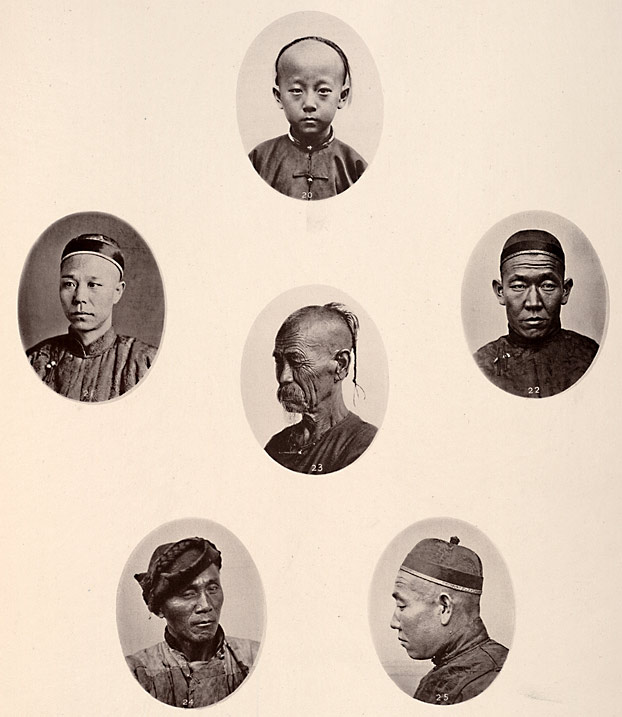 |
| |
“Male Heads, Chinese and Mongolian”
(The two men on the right wearing skull caps are Mongols.)
plate IX, no. 20-25, volume 2
ct2040 (caption) ct2041 (photo)
|
|
| |
Thomson’s focus on facial anatomy and coiffure to distinguish Mongols from the Chinese presented on the same page employs ethnological assessments similar to those used with his Pepohoan cameos. But his treatment of the four cameos showing Chinese heads represents a considerable expansion of the criteria with which he reads facial portraits. Ethnicity remains a concern, but he also comments on class, occupation, age, and character. For the image of the youngster at the top center of his layout (no. 20) he states:
|
|
| |
[He is] a boy of the upper or most educated class, the son of a distinguished civil officer of Canton. He is a fine, attractive-looking little fellow, his full hazel eyes beaming with kindness and intelligence. The oblique setting of the eye, so peculiar to natives of the south, is well brought out in this picture. The face is altogether a pleasing one, but, as is common among children in China, it will gradually loose its attractions as it grows to maturity. The softness of the eye is then frequently replaced by a cold, calculating expression, the result of their peculiar training, and the countenance assumes an air of apathetic indifference which is so necessary to veil the inner feelings of a polished gentleman.  Thomson then uses the image to the left and below the photograph of the boy (No. 21) to “convey an idea of what this bright little fellow may in time become.” Thomson then uses the image to the left and below the photograph of the boy (No. 21) to “convey an idea of what this bright little fellow may in time become.” |
|
Details from
“Male Heads, Chinese and Mongolian”
plate IX, no. 20 and 21, volume 2
ct2040 (caption) ct2041 (photo)
|
| |
Thomson offers a different reading of character for his photograph of the middle-aged male in the bottom left.
No. 24 presents the head of an ordinary Chinese coolie, a fine specimen of the lower orders in China. A man of this sort has enjoyed no opportunities of taking on the polish which is acquired by study and by the high experiences of official life. He is, as a rule, a kindly-disposed person, quite alive to his own interests, and endowed by nature with a profound contempt and compassion for all barbarians who dwell in the pale of Chinese civilization. This will account for the expression he is casting upon me as I am about to hand him down to posterity to be a type of his class.
He is thoroughly honest and sincere in his views, wishing in his heart, when kindly treated by a foreigner, that his benefactor had enjoyed the exalted privilege of being born a Chinaman, and that he may yet, in after periods of transmigration, luckily attain that dignity of birth in some future state.
|
|
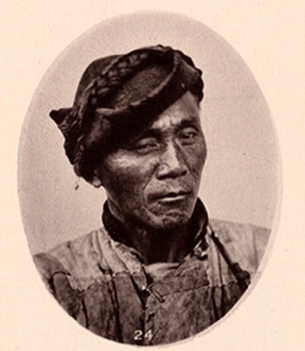 |
Detail from
“Male Heads, Chinese and Mongolian”
plate IX, no. 24, volume 2
ct2040 (caption) ct2041 (photo)
|
|
| |
In these examples, Thomson no longer reads his visual evidence purely as an ethnographer. Instead, he ascribes personalities to his subjects and encourages his readers to indulge in conjecture. In the process, Thomson abandons the objective authority he accords his photographs in the introduction to Illustrations of China and Its People and reverts to pre-photographic pseudosciences of physiognomy (reading a person’s character from the appearance of their face) and phrenology (reading personality from the shape of the skull).
Thomson pairs the image of Chinese and Mongolian males with six cameo portraits depicting female coiffure. His caption adds yet another category to his taxonomy—locale:The women dress their tresses into a diversity of artistic forms to suit the prevailing fashion of the locality in which they reside.
Noting the distinguishing features of each hairstyle, Thomson’s typology correlates coiffure with place, to which he adds age, season, and clan affiliation as follows: a Cantonese girl of the middle class (no. 26), a woman of Southern China in the winter months (no. 27), a young girl from Swatow (no. 28), a woman from Swatow but from a different clan (no. 29), a woman from Ningpo (no. 30), and a woman from Shanghai (no. 31).
|
|
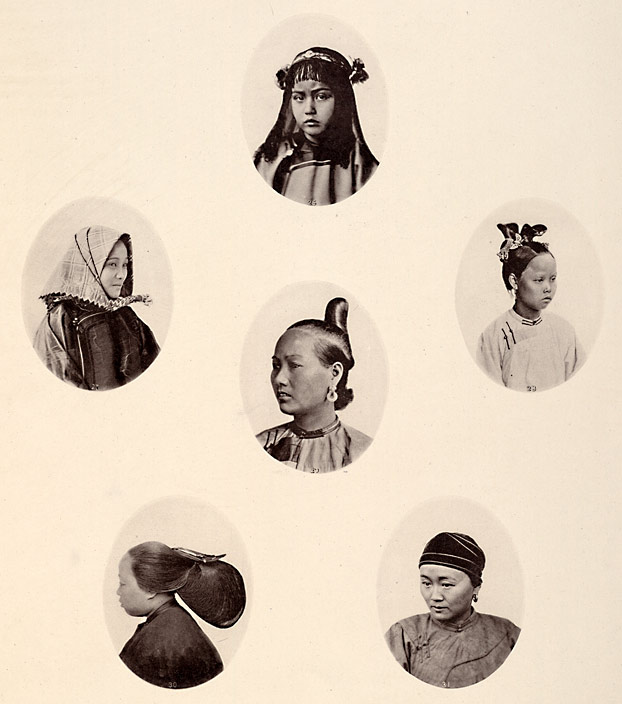 |
| |
“Headdress of Cantonese Girl” no. 26
“Winter Headdress” no. 27
“Coiffure of Swatow Woman” no. 28
“Coiffure of Swatow Woman” no. 29
“Coiffure of Ningpo Woman” no. 30
“Coiffure of Shanghai Woman” no. 31
“Chinese Female Coiffure,” plate X, nos. 26-31, volume 2
ct2042 (caption) ct2043 (photo)
|
|
| |
Thomson expands this selection of female coiffure with a similarly titled plate of cameo photographs appearing in volume four. The first cameo at top center shows yet another woman from Swatow (no. 15), four images are of “married Manchu or Tartar matrons (nos. 16, 17, 18, 20), and the cameo on the bottom left displays the style of headdress worn by Mongol women during the winter (no. 19). His caption focuses mostly on the coiffure and costume of the Manchu women, but in keeping with his treatment of male subjects, Thomson draws attention to the facial features of his Mongol subject: “the face, with its high cheek bones, is one thoroughly characteristic of the Mongol race.”
|
|
| |
“Chinese Female Coiffure” no. 15
“Manchu Female Coiffure” no. 16
“Manchu Female Coiffure” no. 17
“Manchu Female Coiffure” no. 18
“Manchu Female Coiffure” no. 19
“An Old Mongolian Woman” no. 20
“Female Coiffure,” plate VIII, nos. 15-20, volume 4
ct4039 (caption) ct4040 (photo)
|
|
| |
Thomson does not attempt to read character into his female subjects as he did with males. Instead, he opens up another line of commentary that employs a sweeping comparison with Western women.
As will be observed, the chignons are each of them different, and all alike deserve careful study by the ladies of Western lands. The dressing of hair into fantastic forms is naturally a difficult task, and one which, most probably, would shut out the spurious imitators in our own country, for few could throw their whole mind and energy into the work. In China, with these women, the hair is only done once or twice a week, necessity requiring the wearer to economize time. With a view to avoid injuring the elaborate coiffure during sleep, the lady supports the nape of her neck upon a pillow of earthenware or wood, high enough to protect the design from being damaged. In our land the device would imply a sacrifice of comfort, and here and there a case of strangulation would ensure; but no very grave objections could be raised to the novel chignon and its midnight scaffolding, when the interests of fashion are at stake.
Thomson advances this comparison further when commenting on the coiffure of Manchu women:I confess myself unable to explain the mysterious mode in which the tresses have been twisted, but careful study of the illustrations will, I doubt not, reward any lady who may desire to dress her hair “à la Manchu.” The style is simple and graceful, and must have been designed, one would almost think, to represent horns, enabling the wearer to hold her own against her antagonistic husband.… Joking apart, I would seriously advise the ladies of our land to try this chignon, as it would be a decided improvement upon those now in vogue, and should their husbands or brothers be devoted to artistic or literary pursuits, the basis could easily be procured in the shape of a limner’s brush, a ruler, or a paper-knife, while the flowers and other ornamental accessories would be readily found where ladies always obtain them.
It appears from these passages that Thomson is attempting to draw in a broader readership for Illustrations of China and Its People, in this case Western women. And yet, the misogynous undertones of his commentary seem equally intended to entertain his male audience.
Taking into account the full spectrum of his cameo photographs, Thomson defines four distinct ethnicities: Pepohoan, Chinese, Manchu, and Mongol. Facial features provide the primary means to separate the Pepohoan natives and Mongols from his Chinese and Manchu subjects. Costume and coiffure are marshaled as supporting evidence. Thomson uses costume and coiffure to subdivide his Chinese subjects by locale (Canton, Swatow, Ningpo, Shanghai). Costume and coiffure are also used to separate Manchu from Chinese. Thomson makes no mention of any facial features to support this distinction, and the Manchu are not confined to a specific locale. In short, no single, uniformly applied criterion underscores Thomson’s typology.
Thomson’s cameos thus raise several questions concerning his ethnological practice. Was the use of photography to capture ethnographic specimens as unsystematic as these examples suggest? Or was the mixture of analytical criteria and the skewed typology it engendered unique to Thomson? Did he lack the full range of images necessary to conduct a more scientific and systematic study? Did the commercial underpinning of Illustrations of China and Its People, specifically the need to sell albums, force Thomson to opt for an entertaining presentation of his photographic types at the expense of more rigorous taxonomy? The answer is probably yes to all of the above. Thomson’s observations are invariably informative and entertaining, and his visual juxtapositions can be instructive and enlightening. But they are not, by any means, systematic.
While Thomson’s cameo portraits represent only a small number of the “Chinese people” scattered throughout these albums, they nonetheless provide important insights. Themes he initiates while discussing the cameos reappear and are developed further in the captions for his half-length portraits. His readings of coiffure and fashion become motifs on which he constructs detailed descriptions and assessments of cultural practices. Comparisons with the West appear frequently, as do comparisons between the various groups he documents. These provide occasions to make value judgments. To cite perhaps the most prevalent example, Manchu women generally compare favorably with Western women at the expense of Han Chinese whose lives, Thomson observes, are more circumscribed by traditional family and social structures.
|
|
| |
Occupations & Trades
 The majority of Thomson’s types highlight occupations and trades as opposed to dress and coiffure. These too are often critically evaluated, with less emphasis on ethnicity. Instead, Thomson indulges the impulses he displayed with the people encountered along the Yangzi. Photographs of occupations and trades provide an opportunity to assess the people of China as exploitable human resources. This approach is discernable among the first portraits in the first album, which include a schoolboy and a young Chinese girl in Hong Kong. The majority of Thomson’s types highlight occupations and trades as opposed to dress and coiffure. These too are often critically evaluated, with less emphasis on ethnicity. Instead, Thomson indulges the impulses he displayed with the people encountered along the Yangzi. Photographs of occupations and trades provide an opportunity to assess the people of China as exploitable human resources. This approach is discernable among the first portraits in the first album, which include a schoolboy and a young Chinese girl in Hong Kong.
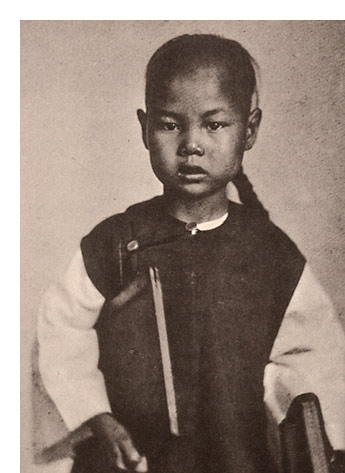 Thomson opens his comments on the schoolboy with a discussion of Hong Kong schools that offer English education to local children. Citing the testimony of teachers who instruct both Western and Chinese pupils, he notes that despite difficulties acquiring the English language, the Chinese student’s “capacity for learning is so great that it will sustain him neck and neck in the race with his European rival.” Thomson suggests that the best application of this capacity is a supporting role in the colonial enterprise as “interpreters, compradors, treasurers, or clerks.” Thomson opens his comments on the schoolboy with a discussion of Hong Kong schools that offer English education to local children. Citing the testimony of teachers who instruct both Western and Chinese pupils, he notes that despite difficulties acquiring the English language, the Chinese student’s “capacity for learning is so great that it will sustain him neck and neck in the race with his European rival.” Thomson suggests that the best application of this capacity is a supporting role in the colonial enterprise as “interpreters, compradors, treasurers, or clerks.”
“A Chinese School-Boy”
plate IV, volume 1 (detail)
ct1018-ct1019 (caption) ct1022 (photo) |
|
| |
Thomson’s caption for the a Chinese girl offers far less hopeful prospects. He notes that women of the upper classes lived cloistered lives and were educated entirely within the home. For upperclass women, this might include some exposure to China’s literary or music traditions, but for the most part girls received training in social etiquette required to serve their fathers and husbands. To this he adds the following assessment:
|
|
| |
[B]ut the science to which they devote themselves with most assiduity is the knowledge of the mysteries of cosmetics and the toilet; how to paint the proper tint, finishing with the bright vermilion spot on the under lip; how to pose the quivering ornaments of kingfisher plumes or sprays of pearls about the coiffure; how to walk with grace on their tiny feet, and to sit down without furling or disarranging a fold of their silken attire.
|
|
“A Chinese Girl”
plate IV, volume 1 (detail)
ct1019 (caption) ct1023 (photo)
|
| |
Thomson invokes a comparison with women of the lower classes to close this caption, stating that the latter “are seldom taught anything beyond the duties of the household, or the more arduous work of bearing burdens or labouring with the men of their families in the fields.” Thomson’s photograph of a Chinese girl thus becomes a critique of the treatment of women in China. And on this point, he taps into a trope deployed throughout the colonial world, whereby indigenous civilizations were measured by the manner in which they treat their women. China fares well compared to Islamic countries but poorly when compared to Japan where, in the imagination of Westerners, women of all classes were accorded both education and freedom of movement.
Despite the poor prospects for women in China, Thomson finds utility in their situation, noting in his description of the Chinese girl that “tea-picking and the rearing of silkworms are also female occupations.” He follows up with a large-format image of women sorting tea leaves in Canton, and a single-page four-image spread illustrating stages in the preparation of tea for export. This is accompanied by a brief history of the tea trade and a description of the varieties of tea produced in China.
|
|
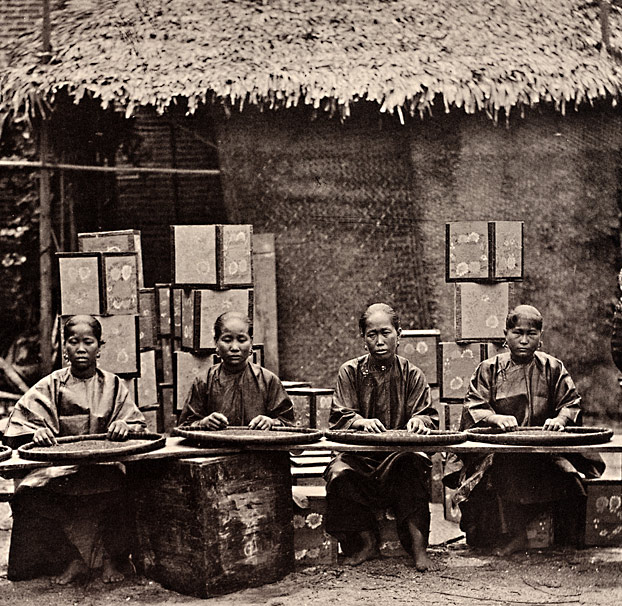 |
|
“Tea Picking in Canton,” plate XIX, volume 1 (detail)
ct1084 (caption) ct1085 (photo)
|
|
| |
A number of images document tea production and preparation for export.
|
|
| |
Thomson’s commentary on women sorting tea leaves, however, strikes a note quite different from his observations elsewhere concerning the “arduous work” which was the lot of uneducated females:Many of the women are pretty or attractive-looking, and move their small well-formed hands with a marvelous celerity, pouncing upon and tossing aside the smallest fragments of foreign matter which may chance to have become admixed with the tea, and which none but a thoroughly trained eye could ever have discovered at all. It is impossible to visit an establishment of this kind and not be impressed with the orderly habits and business-like atmosphere of the place, where a thoroughly organized system of divided labour has produced from the leaf of a single shrub so many varieties of one of the most delicate and salutary of the luxuries we possess.
Thus, while Thomson might disparage the situation of women in China, he seems more than willing to set aside his criticisms when discussing women’s role in an industry that produces “one of the most delicate and salutary of the luxuries we possess.” The distinction rests in his use of the infamous British “we”. Chinese girls may grow up to be slaves to fashion and subject to the whims of male patriarchs, or their lives may be circumscribed by household duties and farm labor, but when they prepare tea for export, they become an indispensable and, in Thomson’s eyes, a picturesque facet of Britain’s global economy.
Thomson made similar arguments concerning the role of women in the silk industry, as silk was equally important to British economic interests in China:This business gives profitable occupation to thousands of the families of small farmers; who set aside a portion of their gardens for the culture of the mulberry shrub. On the wives and daughters of the household falls the business of superintending the various delicate operations connected with the production of silk—their duty it is to collect the eggs, to watch with care the process of hatching, which takes place in April, to nourish with the tender mulberry leaves the tiny worm as he accomplishes his marvelous labours, and then, when he has finished his silken fabric, to arrest his career of industry, and wind off the cocoons for exportation to the looms of Europe. We owe much to China; and perhaps a knowledge of the rearing of the silkworm, and the introduction of silk are two of the greatest boons she has conferred upon Western nations.
Try as he might, however, Thomson’s efforts to photograph silk production failed. On this subject, the cloistering of women was detrimental to his aims, and he had to settle for a single image of two men standing by a silk-reeling machine.
|
|
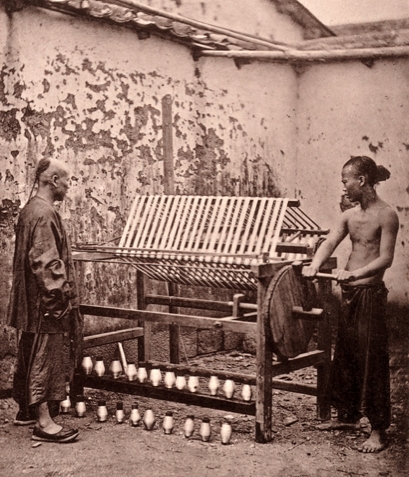 |
  “The superstitious dread with which the people regarded my photographic apparatus rendered it impossible for me to obtain more than this single picture in the silk-producing districts, although I had made a special journey thither, with the intention of securing a full series to illustrate various operations concerned with this branch of industry. “ (from caption) “The superstitious dread with which the people regarded my photographic apparatus rendered it impossible for me to obtain more than this single picture in the silk-producing districts, although I had made a special journey thither, with the intention of securing a full series to illustrate various operations concerned with this branch of industry. “ (from caption)
“Reeling Silk,” plate XXII, volume 1 (detail)
ct1101 (caption) ct1102 (photo)
|
| |
Gentlemen, Soldiers, & Beggars
 Two photographs, jointly captioned as “Cantonese Gentlemen,” extrapolate on themes Thomson introduced with his image of a schoolboy and provide a corollary to the discussion of women employed in tea and silk manufacture. Two photographs, jointly captioned as “Cantonese Gentlemen,” extrapolate on themes Thomson introduced with his image of a schoolboy and provide a corollary to the discussion of women employed in tea and silk manufacture.
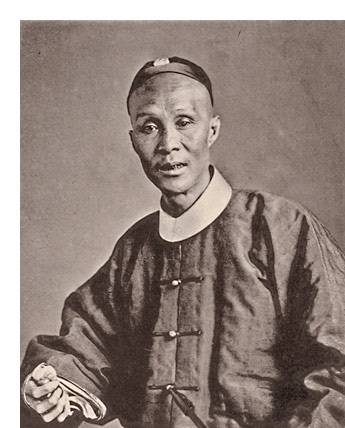 According to Thomson, these two men embarked on radically different paths. The older of the two studied literature and acquired enough familiarity with Chinese classics, law, and history to enter the civil service, where he mastered the arts of bribery and extortion. According to Thomson, these two men embarked on radically different paths. The older of the two studied literature and acquired enough familiarity with Chinese classics, law, and history to enter the civil service, where he mastered the arts of bribery and extortion.
“A Cantonese Gentleman”
plate XXII, volume 1 (detail)
ct1096 (caption) ct1100 (photo) |
|
|
|
  The other is employed as a treasurer in a foreign mercantile house, where “he merits the full confidence and support of his employers.” Accordingly, he has become “a leading man among the native merchants, a member of their best clubs and guilds, and one whose intimate knowledge of foreign businesses diffuses a wide-spread influence among the wealthy traders who dwell at the Treaty Ports.” Thomson concludes with a description of the financial and social success enjoyed by the gentlemen who has adapted to the needs of the global economy.
The other is employed as a treasurer in a foreign mercantile house, where “he merits the full confidence and support of his employers.” Accordingly, he has become “a leading man among the native merchants, a member of their best clubs and guilds, and one whose intimate knowledge of foreign businesses diffuses a wide-spread influence among the wealthy traders who dwell at the Treaty Ports.” Thomson concludes with a description of the financial and social success enjoyed by the gentlemen who has adapted to the needs of the global economy.
|
“A Cantonese Gentleman”
plate XXII, volume 1 (detail)
ct1096 (caption) ct1099 (photo)
|
| |
Thomson makes similar arguments in the caption for his image of Tartar soldiers. He provides a brief history of the Manchu (i.e., Tartar) conquest of China in 1644, focusing in particular on the subjugation of south China that followed. He notes that the permanent garrison established in Canton consists of about 1800 men, but because of inefficient government they are poorly trained, rarely paid, and poor. In Thomson’s eyes, they are a redeemable resource.Thoroughly drilled and disciplined, and with a commissariat that would provide effectively for their wants, they would still make good soldiers.… [A] number of Tartar and Chinese soldiers have been instructed in the system of European drill, and in the use of foreign arms. The reader cannot fail to be struck by the fine manly build and soldierly appearance of the Tartar artillery-men shown in the photograph. These men form the native guard of Sir D. B. Robertson, our consul at Canton.
|
|
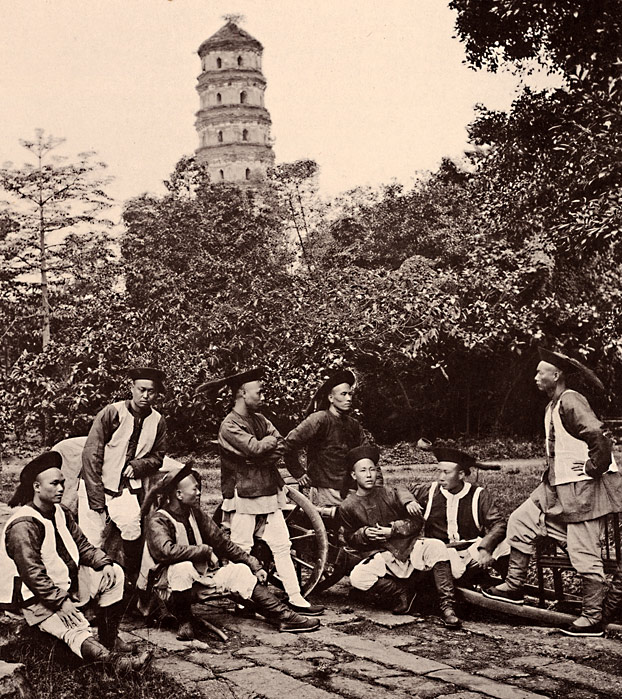 |
| |
“Tartar Soldiers,” plate XIV, volume 1 (detail)
ct1063 (caption) ct1064 (photo)
|
|
| |
With women working in the tea and silk industries, with schoolboys who acquire an English education and gain employment in mercantile firms, and with these rehabilitated soldiers, Thomson uses his photographic types to argue, often emphatically, that a viable role in the neo-colonial administration and economy awaits China’s human resources, provided it acquires the appropriate training and incentives.
A small number of images stand out among Thomson’s wide array of types for both their placement within the four-volume sequence of photographs and the manner in which they are treated. The first photograph of the first volume depicts a middle-aged Chinese gentleman dressed in traditional attire and sitting in the grotto of a Chinese garden.
|
|
  “Prince Kung, now about forty years of age, is the sixth son of the Emperor Tao Kwang, who reigned from A.D. 1820 to 1850. He is a younger brother of the late Emperor Hien-foong and consequently an uncle to the reigning Emperor Tung-che.” (from caption)
“Prince Kung, now about forty years of age, is the sixth son of the Emperor Tao Kwang, who reigned from A.D. 1820 to 1850. He is a younger brother of the late Emperor Hien-foong and consequently an uncle to the reigning Emperor Tung-che.” (from caption)
“Prince Kung”
plate I, volume 1 (detail)
ct1011 (caption) ct1012 (photo) |
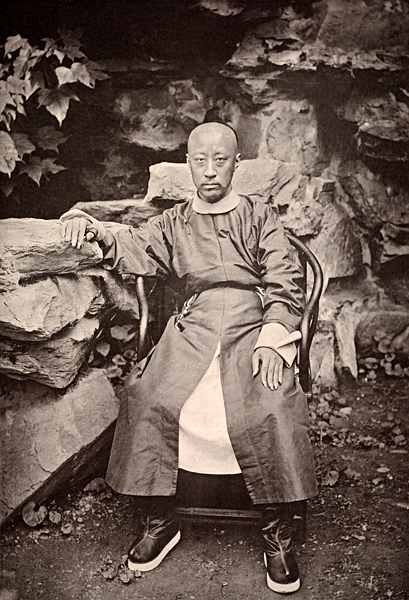 |
|
| |
Volume four opens with a similarly conceived photograph: three men in traditional garb seated in the courtyard of a traditional house.
| |
| |
“Shen-kwe-fen (left) is the Chinese President over the Board of War…
Tung-sean (middle), Chinese President of the Board of Finance, is a celebrated scholar, and the author of numerous works, notably one of an historical and topographical character… Maou-cheng-he (right), a Chinese, is fifty-six years of age, and President of the Board of Works…” (from caption)
“The Government of China”
plate I, volume 1 (detail)
ct4010-ct4011 (caption) ct4012 (photo)
|
|
| |
The plate immediately following is comprised of four mid-sized photographs, each of which poses a single male subject, in this case wearing traditional Manchu costume, seated or standing in the same courtyard.
|
|
| |
“Wen-siang, Manchi Minister of State (2)
Li-hung-chang, Governor-General of Pei-chih-li (3)
Cheng-Lin, Manchu Minister of State (4)
Paou-keun, Manchu Minister of State (5)”
plate II, volume 4
ct4013-ct4014 (caption) ct4015 (photo)
|
|
| |
As frontispiece illustrations to two of the four albums, the men in these images assume considerable importance in Thomson’s conception and presentation of China. Thomson raises their status further by identifying these men by name. Prince Kung, a member of the imperial family, opens volume one, and by extension the entire project. The seven men fronting volume four (devoted almost exclusively to Peking) are identified as prominent members of the national government. These photographs function as types in the conventional sense of the term—human subjects wearing traditional costumes indicative of their ethnicity and social status, presented in a setting befitting their occupation and financial means. But in naming the men depicted in these photographs, Thomson invests the images with a degree of individuality not normally accorded a type. He turns these types into portraits, which elicits the question: why these men?
The elevated social position of the men featured accords them a level of individuation unwarranted for most of Thomson’s types, and the captions convey more specific reasons why these portraits appear in an otherwise ethnological treatment of the people of China. For the image of Prince Kung, Thomson begins by describing his royal heritage. This affords an opportunity to explain the social structure underpinning Chinese nobility. Through this portion of the caption, Thomson treats Prince Kung as a type, albeit a very exclusive type. But he also adds the following:Prior to 1860 he was little known beyond the precincts of the Court; but, when the Emperor fled from the summer palace, it was he who came forward to meet the Ministers of the Allied Powers, and negotiate the conditions of peace. He holds several high civil and military appointments, the most important that of member of the Supreme Council, a department of the Empire resembling most nearly the Cabinet with us. Quick of apprehension, open to advice, and comparatively liberal in his views, he is the acknowledged leader of that small division among Chinese politicians who are known as the party of progress.
In other words, Prince Kung was a key figure in the negotiations ending the Opium Wars. Moreover, he represents a progressive (i.e. pro-Western) faction in the government.
Six of the seven government officials fronting volume four are discussed in a caption titled “The Government of China.” Thomson lists their official positions and duties. For some he provides a brief biography and/or a short statement framing their political dispositions. In all cases they hold credentials and attitudes similar to Prince Kung, but one among them, Li-hung-chang, is accorded a lengthy caption all to himself. Thomson’s opening statement suggests why he chose to focus his attention on Li.
Li-hung-chang stands foremost among the viceroys of the eighteen provinces of China as the man who exerts, probably, the greatest influence on the progress and Destinies of the Empire.
|
|
|
|
 “Li-hung-chang, “Li-hung-chang,
Governor-General
of Pei-chih-li”
plate II, volume 4
(detail)
ct4013-ct4014 (caption)
ct4015 (photo)
| |
| |
Continuing in this vein, Thomson notes that Li is well known to foreigners for the assistance he offered in putting down the Taiping rebellion, for establishing the Nanking arsenal, and for modernizing the Chinese military. Thomson puts these accomplishments in perspective with a lengthy argument concerning the prospects for China’s future in which comparisons with Japan’s rapid modernization emerge as a central theme. Returning to the subject of the photograph, Thomson begins a detailed biography of Li by further extolling his importance to China:I need no excuse for introducing details regarding the life of a man such as Li-hung-chang, who occupies the most prominent position in China, and thus exerts a powerful influence on the well-being of nearly one-third of the human race.
On concluding this biographical sketch, Thomson reclaims his role as an ethnographer—he describes Li’s physical appearance as if defining the parameters of yet another Chinese type:He is now the greatest son of Han, and in appearance the finest specimen of his race which it has been my lot to come across. He stands six feet high, his bearing erect and noble, and his complexion exceedingly fair, while dark, penetrating eyes, and a mouth shaded by a dark brown moustache, betoken inflexible determination.
Remove the reference to Han from this passage, and Thomson could very well be describing a Caucasian. His concluding statement reinforces Li’s trans-racial status with an assessment of his pro-Western character and outlook:
Although thoroughly Chinese by sympathy and education, Li-hung-chang has an intense admiration for our sciences, and for the inventive faculties displayed by the races of the West. He is also ever ready to admit the superiority of our arts and appliances, and eager to advocate their practical introduction into China.
|
|
 |
| |
Within Thomson’s photographic types, these portraits provide
exemplars of what we might refer to as “good” Chinese.
|
|
| |
There are, scattered among the four volumes of photographs, polar opposites to the types Thomson favors with positive commentary. For example, the rehabilitated Tartar soldiers discussed earlier from volume one stand in sharp contrast to Manchu soldiers appearing in volume four. Thomson notes in his commentaries on the latter that most of the imperial troops he encountered on a military exercise north of Peking were still equipped with bows and arrows or old fuse matchlocks.
|
|
| |
Thomson’s photographs relating to China’s military.
|
|
| |
A more critically incisive comparison can be found in Thomson’s description of an “old Tatar bannerman.”
[A] humble member of the Manchu camp, who kept watch at the gate of the French hotel by night; and although in the pay of the government, and allowed a salary sufficient for his own support, yet, by the time the amount reaches his hands through the official channel, it dwindles to about six shillings a month, and a regulation sheep-skin coat once a year.… Wrapped in sheep-skin coat, and in an underclothing of rags, he lay through the cold nights on the stone step of the outer gateway, and only roused himself at times to answer the call of his fellow-watchman near at hand.
|
|
  “One of the City Guard, Peking,” plate XXII, no. 51, volume 4 (detail) “One of the City Guard, Peking,” plate XXII, no. 51, volume 4 (detail)
ct4103 (caption) ct4105 (photo) |
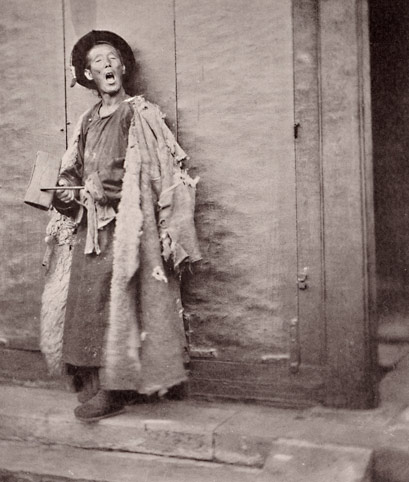 |
|
| |
Thomson affirms the destitution of this individual, so apparent in the photograph, with a description of his daytime occupation as a rag picker. As is, this type is hardly an endorsement of China’s past, present or future, but Thomson ratchets up the intensity of his criticism when identifies the man as Old Wang, an “unfortunate specimen of the soldiers of the standing army, the bold conquerors who once subjugated China.” Once again, a photographic type takes on the qualities of an individualized portrait, but one that stands in stark contrast to the progressive government officials presented earlier in the same volume.
Illustrations of China and Its People is inhabited by types that Thomson clearly regards as inimical to a productive China. His dislike of Buddhists, discussed below in “Reframing the Past,” provides one such example. And he has nothing but disdain for the hordes of beggars plaguing Chinese cities and preying on their inhabitants.
|
|
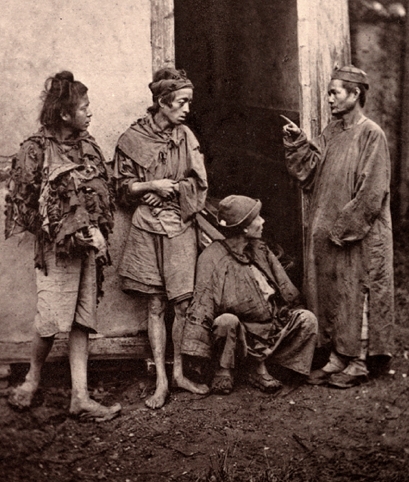 |
  “Professional beggars are numerous in all parts of China, but it is in the larger cities that they more particularly abound, and their skill in dodges and deception would have furnished advantageous hints to the mendicants who used to infest our English thoroughfares. In China the beggar pursues his calling unmolested, and even has received for himself a recognition and quasi-protection at the hands of the civic authorities.” (from caption)
“Professional beggars are numerous in all parts of China, but it is in the larger cities that they more particularly abound, and their skill in dodges and deception would have furnished advantageous hints to the mendicants who used to infest our English thoroughfares. In China the beggar pursues his calling unmolested, and even has received for himself a recognition and quasi-protection at the hands of the civic authorities.” (from caption)
“The Chief of the Thieves”
plate XXI, no. 53, volume 2
ct2082 (caption) ct2086 (photo)
|
|
| |
As with his treatment of Old Wang, however, it is important to recognize that these types provide Thomson with convenient scapegoats representing the real target of his ire. Thomson’s most vitriolic criticisms are seldom leveled at the people appearing in his photographs. More often than not, he targets systemic inequities and failures of Chinese culture. In other words, the types he finds so disagreeable are symptoms of the corruption and disorder of a civilization in decline.
Opium Addicts
There is a measurable degree of earnestness in Thomson’s attempts to argue these causal relationships, and yet, with one especially debilitating social practice—opium consumption—Thomson seems more than willing to disparage its symptoms while remaining purposefully ignorant of its causes.
Thomson’s captions on opium smoking offer a detailed treatise on the preparation and consumption of the drug, quotes from a medical doctor, and a lengthy anecdote of an artist acquaintance who succumbed to addiction. But his photographs of opium smokers also function as types when, opening with “[t]he opium pipe has become an indispensable Chinese luxury,” Thomson describes the social consequences of addiction. The first of his photographs situates opium smoking in the public sphere:Many of the worst class of beggars are confirmed opium-smokers, — men who have been dragged down from positions of comfort or affluence by the vice. Long lost to all sense of honour and self-respect, and sunk so low as to become the begging pests of their former friends and associates, they would give the last rag that covers them to gratify their passion for the drug that has consumed their reputation, their substance, and their flesh. |
|
  “Opium-smoking in a Restaurant” “Opium-smoking in a Restaurant”
plate IX, volume 1 (detail)
ct1040 (caption) ct1045 (photo) |
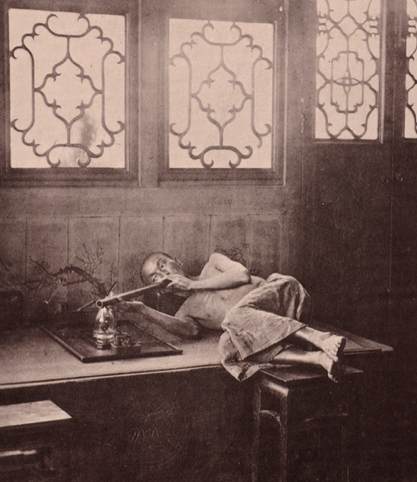 |
|
| |
The second image shifts the scene to the private homes of “the wealthier classes of the Chinese.” Here, the effects of addiction are measured on the family:
Opium-smoking is one of the most enslaving vices, which, when it has secured its victim, gradually poisons and destroys the finer feelings of his nature, causing him to neglect his business, dispose of his property, and even sever the sacred ties of kindred by selling his wife and children into slavery so that he may gratify his ruling position.
Thomson’s condemnation of opium smoking would accord well with the beliefs of his viewers, as most English men and women were uniformly appalled by the habit. But like Thomson, few would openly acknowledge that China’s opium addiction was in good part of Britain’s making.
|
|
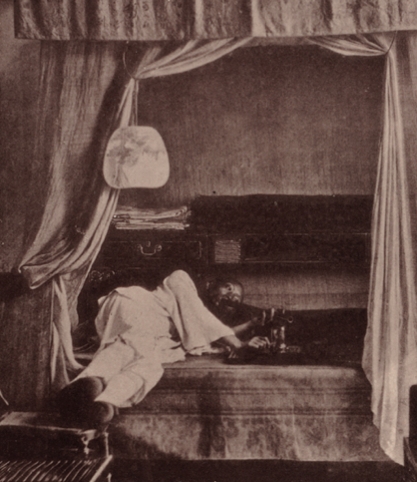
|
  “This picture shows the method in which opium is smoked by the wealthier classes among the Chinese. The smoker here has leisure and money at his command, so that he is able to indulge freely in the use of the drug.” (from caption)
“This picture shows the method in which opium is smoked by the wealthier classes among the Chinese. The smoker here has leisure and money at his command, so that he is able to indulge freely in the use of the drug.” (from caption)
“A Whiff of the Opium Pipe at Home”
plate X, volume 1 (detail)
ct1046 (caption) ct1049 (photo)
|
|
|





